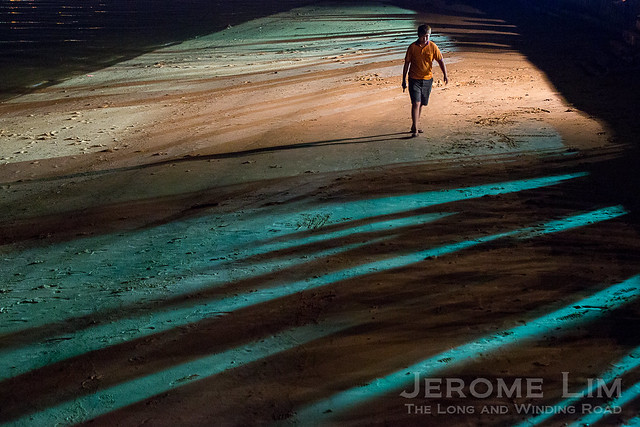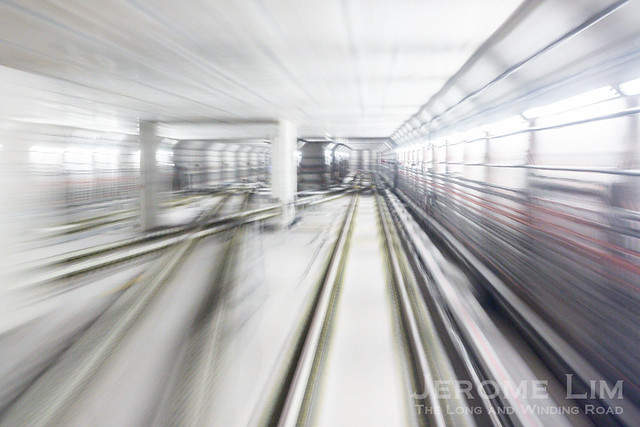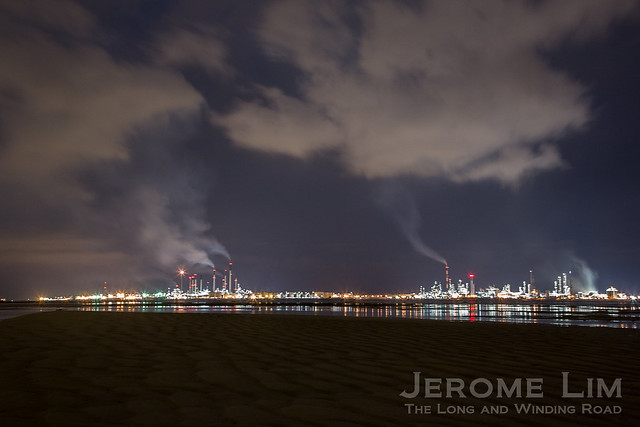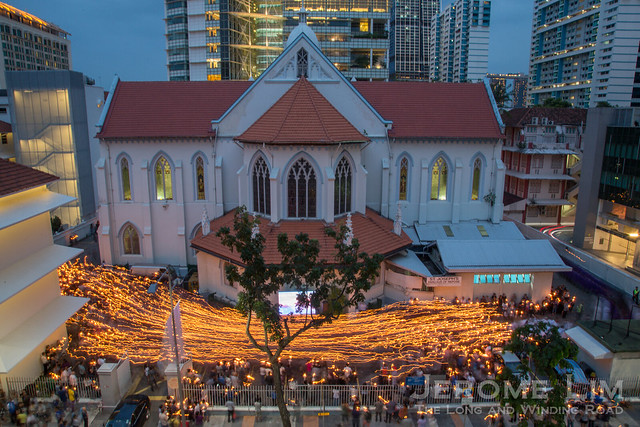What defines Singapore isn’t just its well photographed icons of the modern age, food, its colourful festivals and its now ubiquitous blocks of public housing flats. Lots go on without ever being noticed, including what these twelve untypical views of some of what makes Singapore, Singapore, depict:
The darkness at sunrise

An incoming storm.
Rainstorms are very much a part of life in Singapore. They can be a nuisance, but are also welcomed for the cooler temperatures they bring. One storm system that is particularly dramatic, arrives with suddenness in the early mornings around dawn, bringing with it a fury of lightning, thunder and heavy rain. The squalls, which blow in from March to November, are known as the Sumatras – after the Indonesian landform they blow in from.
The (once) shimmering shores

Sembawang Beach, one of the last natural beaches, illuminated by the lights of a celebration brought in by one of Singapore’s immigrant communities.
The Malay Annals, the chronicles of the kings of old Singapura, makes one of the earliest recorded mention of Singapore’s shores. In one of it more well-known stories, a glance at the shimmering white sands of then Temasek was all it took to have Sri Tri Buana or Sang Nila Utama sail over from Batam. Confronted by the sight of a magnificent looking beast that the royal party believed to be a lion, Sri Tri Buana decided to remain on the island and establish a kingdom that he named Singapura after the beast. Except for a vicious attack of sawfish – told in another of the annals’ intriguing tales, the shores provided calm. The British East India Company would see great value in the shores some 6 centuries after Sang Nila Utama and came to lay what would be the foundations for modern Singapore.
Crossing at speed

Crossing MRT lines, as seen from a moving train.
Modern Singapore makes a huge investment in public transport infrastructure, a key component of which is the MRT. Construction of the first lines, which was initially resisted, began in the 1980s. Three decades on, Singapore is still in a frenzy of building a criss-cross of lines with a view to reduce the dependence on road transport in the longer term. In will also only be a matter of time before the MRT crossing into neighbouring Malaysia. Plans are in place to have the MRT run under the Tebrau Strait and into Johor Bahru.
The lights do not go out on the shipyards

Working lights at Sembawang Shipyard at dawn.
Once thought of as a sunset industry, the shipbuilding and repair business continues to serve Singapore well. With a long tradition in the industry, it would only be after independence that the business came to the fore. The two shipyard giants, Keppel and Sembawang, have their roots in the post-independence era, built on facilities inherited from civilian and military facilities established by the British. Both were an important source of jobs in early years and together with other shipyards, have established a reputation for efficient turnaround repair times. One contributing factor is the effort put in by some of the hardest workers across the industries that keep the shipyards running 24-7 whenever that is needed.
Upwardly mobile

Inner workings of a multi-level ramp-up logistic centre revealed by its illuminations.
The entrepôt trade, and what supports it, is one of the things Singapore has been built on. The arrival of the age of containerisation in the early 1970s, transformed the trade and also the ports and goods handling facilities. Like in public housing and in the light industrial landscape, goods handling has also now gone high-rise. Multi-level ramp-up logistics centres have become a feature of the industrial and suburban landscape over the last two decades with much more being built. The transport and storage trade, associated with these facilities, accounts for a significant 8% of the GDP.
Offshore oil

The petrochemical complex on Pulau Bukom and Pulau Ular / Pulau Bukom Kechil, seen from an offshore patch reef. Pulau Bukom is the site of Singapore’s first oil refinery.
For the oil industry in Singapore, going “offshore” takes on another meaning. Singapore’s beginnings as a main refining centre was in 1961 when Shell opened the first refinery offshore on the island of Pulau Bukom. Singapore has since also ventured into petrochemical processing. Although there are some onshore facilities still running, much goes on offshore with a man-made island made from a cluster of islands off Jurong, Jurong Island, being a main centre. Petrochemical processing facilities have also sprouted up on an expanded Pulau Bukom and on the neighbouring island of Pulau Bukom Kechil (which now has Pulau Ular and Pualu Busing appended to it).
The light brought by a moving dock

Inside the belly of a Landing Ship Tank.
One way in which Singapore plays its part as a member of the international community is in providing humanitarian assistance in the event of crisis and disaster in the region. With 4 locally designed and built Landing Ship Tanks capable of moving men, machine and cargo over large distances, the Republic of Singapore Navy is well equipped to provide support for such a response when needed – as was seen in the aftermath of the 2004 Boxing Day earthquake and tsunami in Aceh.
Corridors of sin and also of salvation

A corridors of sin and salvation. The lights are of a Buddhist Religious Centre.
Geylang may be a neighbourhood that has built a reputation for its association with several of the 7 deadly sins, gluttony and lust included. What is perhaps surprising about the neighbourhood is that it is also where the largest concentration of religious institutions in Singapore can found (see also:Streets of Sin and Salvation).
Islands of many tales and legends

Kusu Island at twilight.
The southern islands of Singapore, once inhabited by members of the Orang Laut community, have long been the subject of myths and legends. Handed down over the generations, the stories – of spirits and genies suggest how the islands were formed and how the islands acquired their names. Sadly, with the communities now dispersed, much is being forgotten. One that will not be forgotten as quickly is that of Kusu or tortoise island, which legend says a tortoise in rescuing two shipwrecked sailors, turned into the island. The island actually resembled a tortise at high-tide before land reclamation altered its shape. Chinese and Malay shrines maintained on the island, continue to attract Chinese devotees, especially during the annual pilgrimage that takes place over the ninth Chinese month,
Regeneration

The deconstruction of the 1973 built National Stadium in 2010, where two perhaps three generations of Singaporeans connected to during the days of Singapore’s participation in the Malaysia Cup football competition.
Regeneration of old places, neighbourhood and places Singaporean have grown to love, is very much a feature of life in Singapore. Many, especially from the older generations have had to cope with the loss of familiar places and the loss of that sense of home such places bring (see Parting Glances: Rochor Centre in its last days, Parting glances: Blocks 74 to 80 Commonwealth Drive and A world uncoloured).
Light of a not so foreign land

Good Friday at the Church of St. Joseph – where the religious traditions of Portugal are most visible in Singapore.
With a large majority of the population made up of the descendants of the ethnic Chinese immigrants and also an influx of new immigrants from the mainland, and large minorities of Malays and those from the Sub-Continent, Singapore’s many smaller minorities tend to be overlooked. Over the years, Singapore has seen the likes of Armenians, Arabs, Jews, Japanese and as well as those from the extended Nusantara flavour the island. There is also a group that has in fact long had links with the area, the Portuguese or Portuguese Eurasians who feature quite prominently. Many have maintained the traditions of their forefathers and it is on Good Friday every year when some of this is seen in the Good Friday candlelight procession in the compound of the Portuguese Church.
Where the light does not shine

Where the light doesn’t shine. Workers on yet another skyscraper construction project waiting for transport to their dormitories, many of which are located in faraway and remote locations, late in the night.
Work goes on on many construction sites, which employ labourers from various countries including China, India, Bangladesh and Myanmar, without whom the skyscrapers of modern Singapore would not have been built. These workers, not unlike the shipyard workers, work extremely long hours and are housed in dormitories located in some of the remotest of locations in Singapore.









































































